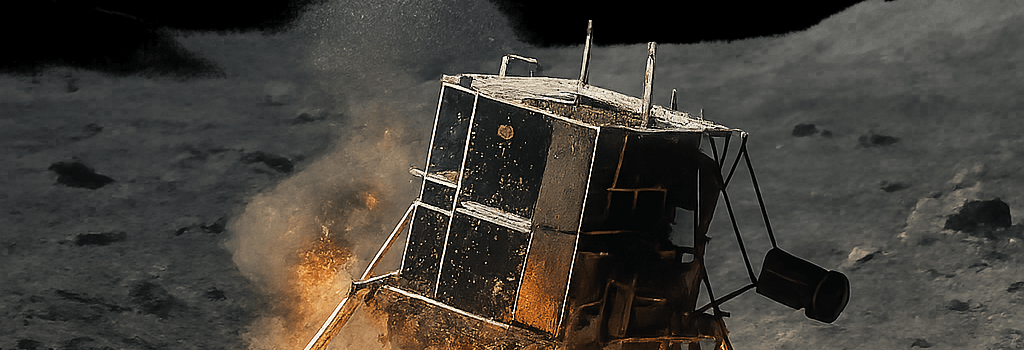ispace Lunar Lander Crashes Due to Rangefinder Glitch

Tokyo, June 6, 2025 — Japan’s private space company ispace suffered its second consecutive Moon landing failure when its Resilience lander lost altitude data during final descent and likely impacted the surface at high velocity. The mishap destroyed a miniature rover, multiple payloads and underscores the technical challenges of commercial lunar exploration.
Mission Overview
Lander Design & Specifications
- Mass (fully fueled): ~1 metric ton (2,200 lb)
- Dimensions: 2 m height × 2.3 m diameter chassis
- Propulsion: Four throttleable main engines, four attitude-control thrusters, hypergolic bipropellant
- Navigation: Inertial Measurement Unit (IMU), star trackers, LIDAR altimeter
- Communication: X-band downlink (2 Mbps), S-band uplink
Resilience launched aboard a SpaceX Falcon 9 on Jan. 12, 2025, following a low-energy transfer trajectory to maximize fuel efficiency. After lunar orbit insertion on May 20, the lander executed midcourse corrections and entered a 30 km perilune for terminal descent to the Mare Frigoris region.
Descent and Failure Sequence
Telemetry Breakdown
Ground teams in Tokyo received nominal health checks through T-minus 10 minutes. At T-minus 90 seconds, the downward-facing laser rangefinder began to report sporadic data. Final valid altitude reading arrived at 192 m, indicating an 8 m/s descent rate. Subsequent telemetry dropped abruptly.
“The deceleration was not enough. That was a fact,” said Ryo Ujiie, ispace CTO. “We must analyze all telemetry to pinpoint root causes.”
Controllers issued a reboot command, but the vehicle remained silent after presumed impact.
Payloads Lost
- Tenacious rover (10 kg, 4 wheeled platform) with shovel mechanism
- Water Electrolyzer (500 g experiment to split H2O)
- Electrolysis cells designed by ESA partner
- Food Production Demo (biosynthesis of microgreens)
- Radiation Monitor (LERoSAM sensor, developed by JAXA)
- Art Project “MoonHouse” (Swedish–Japanese collaboration)
Technical Analysis of Laser Rangefinder Failure
The lander flew a new MEMS-based lidar altimeter operating at 905 nm, sampling at 2 kHz with ±1 cm accuracy and a maximum 10 km range. ispace replaced its previous 1550 nm unit after supplier discontinuation in early 2024.
Preliminary data suggest a timing offset in the photodiode receiver and FPGA processing chain, causing a 20–30 ms delay in valid range measurements. At lunar gravity (1.62 m/s2), such a delay can increase descent velocity by up to 1 m/s, exceeding safe touchdown limits.
“Redundant altimetry is critical for safe lunar landings,” says Dr. Emily Calandrelli, aerospace engineer. “Integrating radar altimeters or stereo-vision cameras could mitigate single-sensor failures.”
Commercial Lunar Market Outlook
As NASA’s Artemis program ramps up and CLPS contracts expand, demand for in-situ resource utilization (ISRU) demonstrations is growing. ispace’s mission carried a NASA-contracted soil sample sale experiment—an early test of commercial procurement of lunar regolith.
To date, seven private lander attempts have occurred:
- Intuitive Machines (Odysseus) – 1 successful soft landing; tipped over
- Firefly Aerospace (Blue Ghost) – first full operational success
- Astrobotic Technology – mission failure post-launch
- Israel’s Beresheet – crashed during descent
- ispace – two consecutive failures
Market analysts estimate a $23 billion commercial lunar payload sector by 2030, driven by lunar communications relays, ISRU, surface habitats and scientific instrumentation.
Future Mission Roadmap
Undeterred, ispace is proceeding with its third mission, scheduled for 2027, under NASA’s CLPS umbrella and in partnership with Draper Laboratory. Key upgrades include:
- Dual-sensor altimetry: LIDAR + Ka-band radar
- Enhanced onboard autonomy with machine learning for hazard detection
- Larger lander platform (1.5 t dry mass) with modular payload bays
- High-bandwidth Ka-band downlink (50 Mbps) for real-time imagery
Conclusion
While ispace’s second landing attempt ended in failure, the mission advances understanding of lunar descent dynamics and sensor integration. Takeshi Hakamada, CEO, remains optimistic: “Landing on the Moon is hard but not impossible. We will analyze, iterate, and succeed.”
The lessons from Resilience will inform not only ispace’s next flight but the broader commercial lunar exploration community as it seeks to establish a sustainable presence on the Moon.